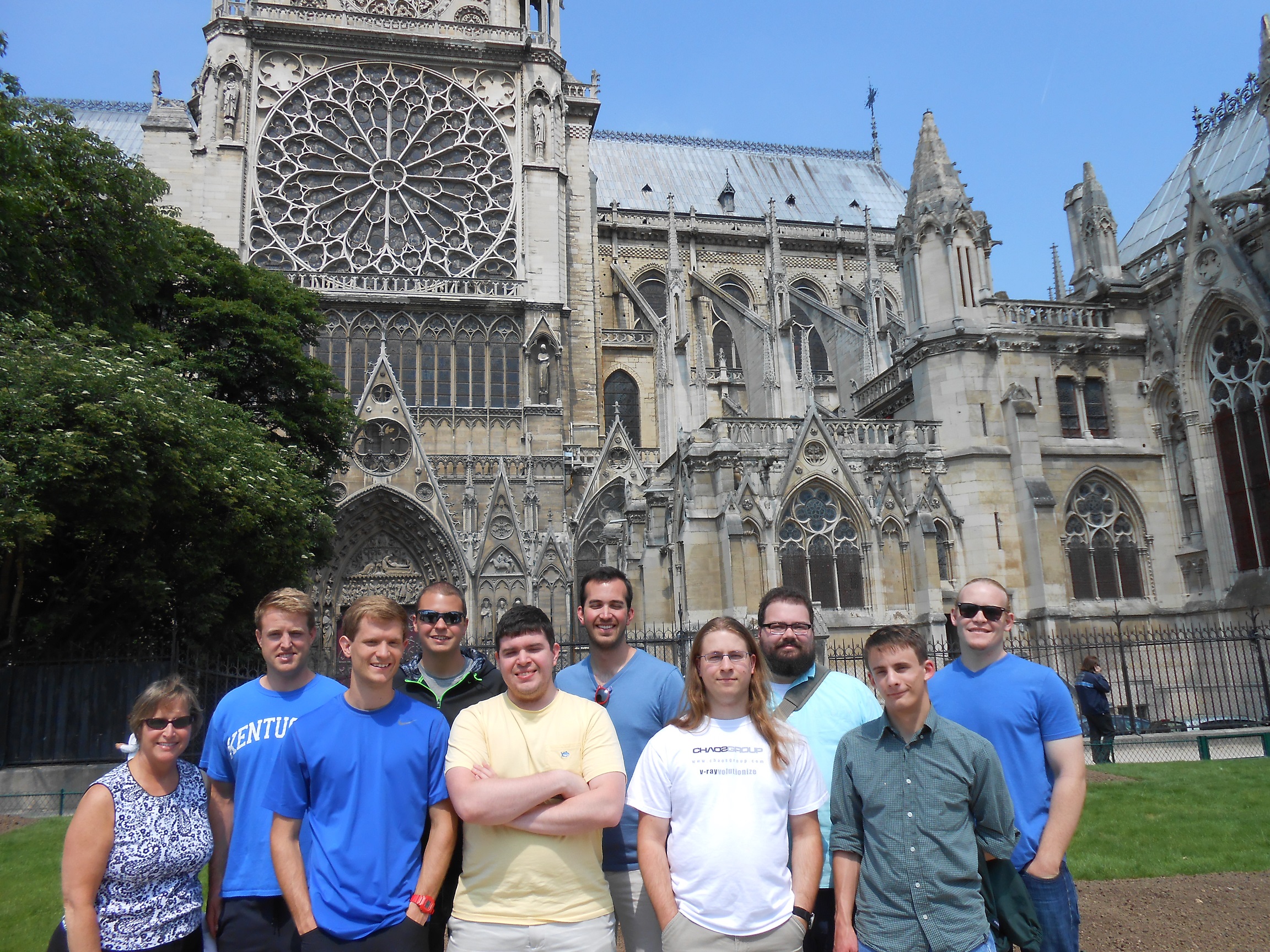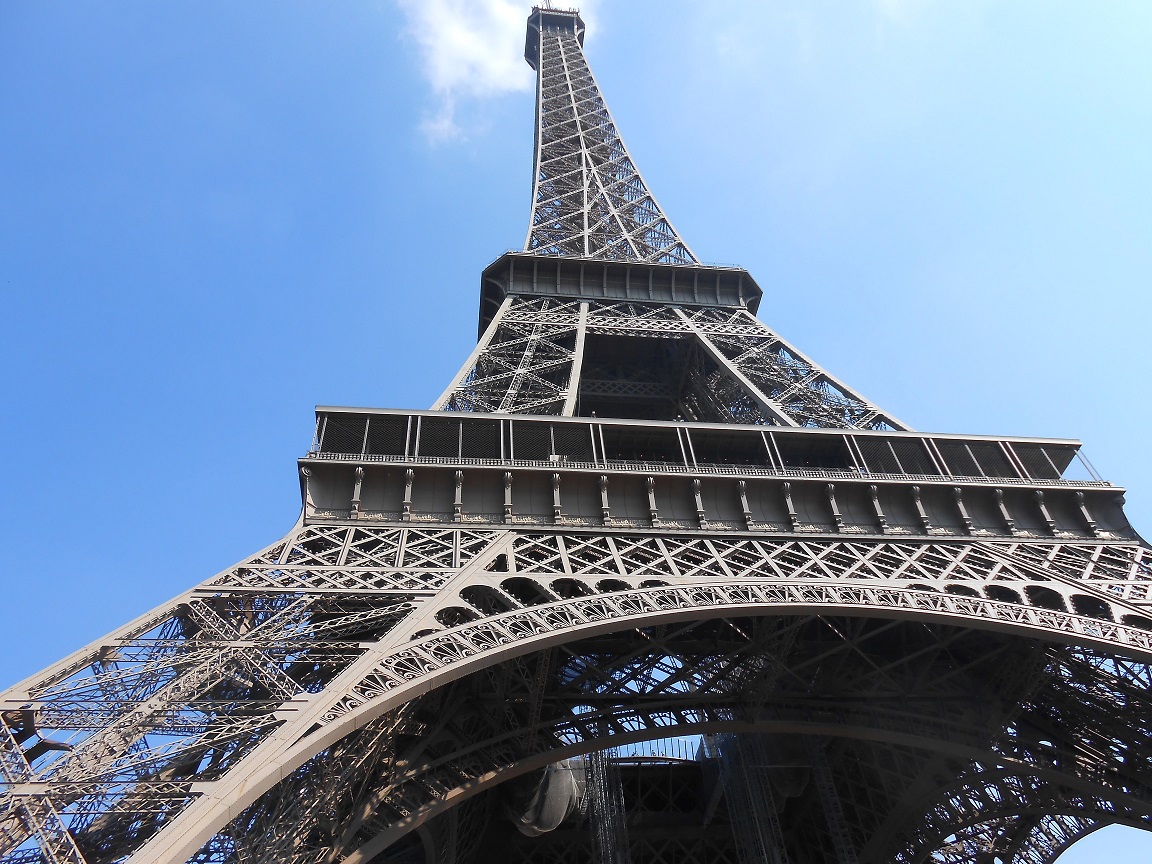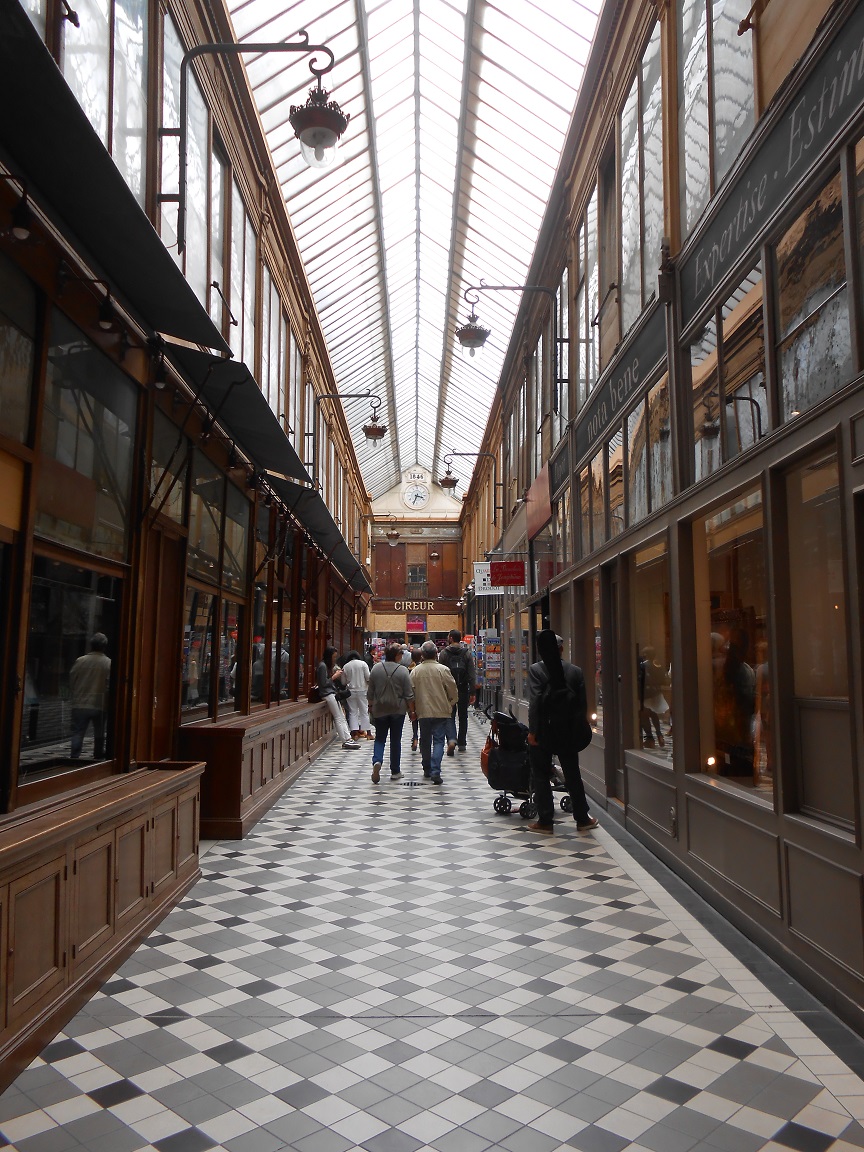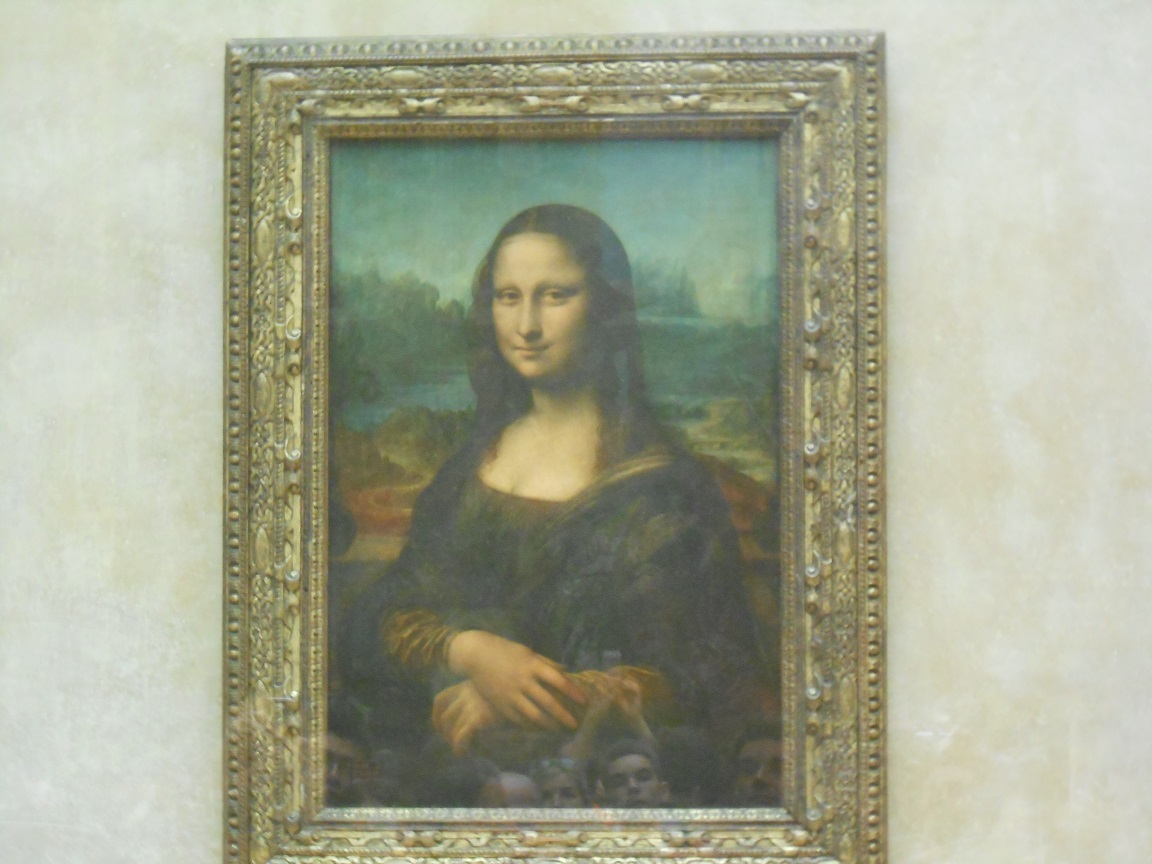Arrival in Paris
31 May 2014
by tjsc222
Hello and welcome to the 2014 BS/MBA program’s international study trip. My name is Jacob Schlueter, and I’ll be taking care of the daily blog posts for this year’s trip. I hope to make this an interesting and informative experience for all of our readers.
Today’s first event was meeting at Hotel Opera Cadet, where we’ll be staying in Paris. Some of us arrived early and had time to adjust to the new time zone, but most of us are still suffering from jet-lag. Thankfully, the only other event was an afternoon bus tour of the city with two stops.
The first stop was at Notre Dame; an ancient Catholic Cathedral completed in the mid-1300s, and one of France’s most iconic buildings. During our visit we learned that last year, for the first time since its completion, the cathedral’s bells were replaced. Our tour guide explained that each bell has a name and that the original mechanism designed to ring the bells is the same as what we use today, a fascinating testament to the ingenuity of medieval construction. Our second stop was at the Eiffel Tower, another well-known building in Paris, but one that the French originally hated. As part of our tour, we rode all the way to the top of the tower for a breathtaking, though hazy, view of the city. The rest of the tour was spent listening to our guide tell us about many of the city’s other landmarks as we drove past, including the Louvre, the Arc de Triomphe, and the Opera Garnier.
Overall it was a fairly relaxed day, focused on giving us time to adjust to the time difference. In the free time before meeting up or after the tour, our group has found a number of interesting parks and restaurants close to our hotel, leaving us plenty of places to visit during our free day tomorrow.


Exploring Paris
1 Jun 2014
by tjsc222
Today was our free day in Paris, where each of us was allowed to spend the day as we saw fit, primarily so that we would have more time to recover from jet-lag before our company visits begin tomorrow. Since it would be a waste to sleep away the day in Paris, however, most of us went out to enjoy the town for a good portion of the day. Some of our travel group made the trek to Versailles, while others made their way to the river and wandered around the area near the Louvre. As for me, I spent a large portion of the day at the hotel discovering the cause of and eventually fixing a problem with my computer, which limited how much time I could spend outside.
Even so, I managed to accomplish my personal goal of thoroughly exploring the streets close to our hotel to get a better idea of what life in Paris is like. My favorite among the day’s sites were the “Passages” close to the hotel. These “Passages” are covered pedestrian-only streets that were commonly built during the 19th century to shield wealthy shop-goers from the elements. The idea behind these “shopping arcades,” as they can also be called, later gave rise to the shopping malls that are now prevalent in the U.S. and other developed countries.
With the day drawing to a close now, all of us are looking forward to tomorrow’s morning visit to Thales University as well as the tour of the Louvre planned for the afternoon.

Thales University and the Louvre
2 Jun 2014
by tjsc222
Today we had our first company visit at Thales University, an education and training focused branch of the Thales Group. The extent of our visit was working with a former member of France’s air force in a practical training session about competition and collaboration. More specifically, we were tasked with a flight simulation scenario wherein the goal was to rescue survivors following a natural disaster. The group was divided into two teams which were graded based first on the number of survivors rescued and later which of the survivors were rescued. Due to these criteria, some rather fierce competition emerged between the two sides, which I feel may have reduced the overall efficiency. In spite of this, both groups managed to pull together a great deal in the end when we were suddenly given a collaborative task, coming up with a number of creative ideas to improve efficiency for the benefit of the whole rather than the individual team. The combination of tasks proved to be both a fun and effective method of demonstrating the challenges and benefits of collaboration between companies that normally would compete against one another.
After leaving Thales, we had a packed lunch on the way to the Louvre where we spent the greater part of the afternoon. As expected of the world’s largest museum, the Louvre was a fascinating place to visit, both for its architecture and history as well as the hundreds of thousands of works it houses. During our visit, we walked through two of the museum’s three wings, though this meant that we had to move rather quickly, which left us relatively little time to admire the individual works. Naturally, we got to see the Mona Lisa, which is one of surprisingly few works in the museum housed in a climate-controlled, protective, case.
The day’s events concluded with our welcome dinner at a very nice restaurant several blocks from our hotel. The food was delicious, and the service superb, making dinner a perfect way to draw our busy day to a close.


Alcatel-Lucent and Aeroports de Paris
3 Jun 2014
by tjsc222
Today was our second and final day of business visits in Paris with two companies on the itinerary for the day. The first company was the telecomm company Alcatel-Lucent, where we were briefed on the company’s strategies, current challenges, and historical approach to their business. Innovation has long been an integral part of their corporate strategy, which has contributed to their continued success, and which they are confident will secure their market position in the face of growing competition from developing regions. During our classes over the past year, we have learned that continuous innovation is one of the best ways for a corporation to secure and maintain lasting success; however, it can be challenging to maintain, as innovation requires a substantial commitment to the research and development of new products.
Our second stop was at Charles De Gaul Airport, one of the Aéroports de Paris, where we had the chance to see the facility’s inner workings. Seeing the facilities up close gave us a better understanding of the complexities of airport construction and management, but also illustrated the importance of maintaining good relationships with business partners, in this case between the airports and the companies that make use of their expansive facilities.

Arriving in Toulouse
4 Jun 2014
by tjsc222
Today we arrived in Toulouse after a five hour train ride from Paris. For the remainder of the day, we went on a guided tour of the city and some of its best known features. As a primarily cultural activity, the focus of the tour was on the culture and history of Toulouse, which we learned is the oldest city in France. Our first stop was at an archaeological museum recounting Toulouse’s origins, starting with the Gauls through the Romans up to the time when Christianity emerged as the dominant religion of the region. Our next stop was the Saint Sernin Basilica, a Romanesque cathedral originally completed in 1180, which is still in use today and which was only a short distance from the museum.
After the basilica and the museum, we continued on to visit the river bank near one of Toulouse’s oldest and most scenic bridges. We also visited the city government building, which is filled with exquisite artwork and ended our tour with the mansion of a wealthy middle-ages dye merchant whose home has since been converted into a museum, though we were unable to go inside the building today. Overall the tour provided us with a great deal of information about the city and also gave us time to relax and unwind after our long trip so that we can be better prepared for the companies we’ll be visiting tomorrow.


Airbus and Thales Alenia Space
5 Jun 2014
by tjsc222
Today we conducted both of our planned business visits in Toulouse, meaning that we have now completed half of the business visits planned for the trip. Our first destination was Airbus, where we had a chance to see the final assembly facility for the A380, the company’s largest passenger plane. After the A380 assembly site, we visited another facility to meet with one of the marketing managers for the company who explained a great deal about the company’s business strategies. Of particular interest to me was their emphasis on employee mobility, lean manufacturing, and diversity initiatives, all of which we discussed regularly during our classes last year. These practices were interesting to learn about, but it was truly fascinating to see them in use by a large multi-national company like Airbus.
Our second destination of the day was Thales Alenia Space, the largest satellite manufacturer in Europe. Due to the sensitive nature of satellite electronics and other payload components, the focus of Thales Alenia’s manufacturing, we could only look in at the production and testing labs through windows to ensure that none of the components would be contaminated. Presently, they are producing satellites for countries around the world, including Russia and the U.S. Additionally the representative we met with today explained that, like Airbus and many other companies, Thales has begun practicing lean manufacturing techniques to improve their efficiency. That representatives from both companies mentioned lean manufacturing by name really speaks volumes about how applicable our lean training will be wherever our professional careers take us.

Carcassonne and Narbonne
6 Jun 2014
by tjsc222
Today we visited the ancient cities of Carcassonne and Narbonne. Carcassonne is an ancient fortress city which was originally built by the Romans. After the Romans departed the region, the city’s walls were modified to increase their height. Later, in the 13th century, the fortress was conquered by the king of France and a second wall was added to the fortress, giving the city the approximate shape it still has today. Though the fortress city is a popular tourism spot, there are still some people who live within the city’s walls. It was a fascinating place to visit, as the architecture is very different from that of Toulouse and modern Paris; in fact, it is likely one of the best examples of medieval architecture remaining in existence.
Our second destination, Narbonne, was also once a Roman port, though the sea has since receded too far away to easily conduct sea trade. Our primary focus in Narbonne was its cathedral, the third highest in all of France, and the tallest in southern France. Interesting to note is that the cathedral never reached its originally planned size, as doing so required the destruction of a portion of the city’s then-existing walls. The bishop heading the project attempted to negotiate with the local government, but was unable to convince them to tear down part of the wall to make way for the cathedral, and so a wall was added to cap the cathedral at the size it was able to attain, and it has remained the same size since. In addition to the cathedral, we briefly visited the palace where the archbishop once lived as well as remnants of a Roman roadway and the city’s canal, which connects it to the Mediterranean Sea.
This is our last day in Toulouse, but our time here has been well worth it. Tomorrow we make our way to Munich.


Arriving in Munich
7 Jun 2014
by tjsc222
Today we arrived in Munich, the beginning of our week in Germany. But before our arrival, we had an early morning to prepare for our flight out of Toulouse, getting up around 5:00 am and leaving the hotel around 5:30. After a layover in London, we touched down in Munich a little before 4:00 in the afternoon and by 4:30 the city tour we had planned for the last half of the day had begun.
During our tour, we visited a number of the most iconic locations in the city, the oldest church in the city, which has existed in some form since before the city’s founding in the Middle Ages, the “English Garden,” which was named for the style of landscaping used, and, of course, we had to visit the iconic Hofbrauhaus, though only briefly. Perhaps the most interesting stop of the day was the Rathaus-Glockenspiel, which sounds a number of German songs through bells and re-enacts two iconic scenes from Bavarian history at 11:00 am, with additional re-enactments at 12:00 pm and 5:00 pm during the summer.
The day’s events ended with our arrival at the hotel, the nH Deutscher Kaiser, likely the best hotel we have stayed in thus far. Tomorrow we’re going visit the Dachau concentration camp and visit more sights in the local area.

Dachau and Schloss Nymphenburg
8 Jun 2014
by tjsc222
Today we conducted a number of cultural exploration activities in Munich, consisting of three primary stops. First, we visited the Dachau Concentration Camp, likely the most solemn place we’ll visit during our time here in Europe. The camp consists of some original and some restored buildings and has stood as a memorial for those that died there and in other camps during the Nazi reign in Germany. It’s a rather haunting place to visit, knowing what terrible things happened there, but I also think that it was very beneficial to see, as it lends a sense of reality to the horrors of the Third Reich and the Second World War.
Our second stop was the city of Dachau where we walked around, enjoyed lunch and some snacks, and finally stopped by what remains of the former Bavarian king’s summer palace. Though our visit was restricted to the yard outside the building, it was a very interesting place to visit, especially for its view of the land below. In the distance, we could clearly make out some of Munich’s tallest structures, and even further away, barely visible today thanks to the heat, we could see the Alps. I can only imagine how breathtaking the view would be on a clearer day.
Finally, we stopped by Schloss Nymphenburg, the Nymph Palace, built by the Bavarian kings in the 16th and 17th centuries. Originally construction began as a gift from the king to his wife for the birth of their first son after ten years of marriage. However, neither the king nor the queen lived to see its completion, as it took more than a full century to complete. The interior is decorated in the Rococo style, with ornate frescoes and paintings decorating the walls all throughout. Both in front and behind the palace, expansive gardens were planted, which are maintained to this day.
Tomorrow is our free day, where many of us are planning to visit Neuschwanstein and the local area, so please look forward to seeing what picture we take there.


Free Day in Munich
9 Jun 2014
by tjsc222
Today was our free day in Munich. Most of us took the trip to Neuschwanstein, the famous castle built by Ludwig II, King of Bavaria in the late 1800s. Not only was the castle itself fascinating, but the scenery nearby was gorgeous as well. We all enjoyed the trip greatly, especially those of us who took the time to go swimming while we were in the area. The water was deliciously cool, which made the day’s otherwise scorching heat much more bearable. We started back towards Munich around 5:30, and arrived back at the hotel around 8:30.
Overall, it was excellent way to spend our free day, which gave us plenty of time to have fun and unwind before our busy day of visits tomorrow.


Munich Business Visits
10 Jun 2014
by tjsc222
Today we conducted our business visits here in Munich. We started off the day with a visit to Allianz Arena, the soccer stadium built for the FIFA World Cup in 2006. We learned a great deal about the “football” culture in Germany, but we also learned quite a bit about the business workings of the arena and the unique engineering involved in its construction. Currently the turf is undergoing maintenance between seasons
Our second stop was MAN Truck and Bus. During our visit we saw the first diesel engine ever created and went on a thorough tour of the truck manufacturing line. A large focus of the tour was the company’s great attention to detail and quality in their trucks as well as how they use Just in Time strategies to improve their efficiency. At present, it takes between seven and eight hours for a truck to go from start to finish within the facility, but a completed truck rolls off the line every six and a half minutes.
Our final stop was at a local brewery where we learned the ins and outs of the beer production process. During our tour we learned that beer production in Germany has many restrictions reminiscent of the restrictions on bourbon production in the U.S. We also learned that Munich’s world-known Oktoberfest also has protective regulations in that the only beers that can be sold for the event in Munich are those produced within the city limits.
Tomorrow morning we head for Stuttgart, the final city we’re visiting during the program.


Farewell Munich, Hello Stuttgart
11 Jun 2014
by tjsc222
Today we traveled to Stuttgart, our final destination before the end of the program. Due to the travels, we only had one item on our itinerary after our arrival, which was our first company visit at Kpunkt Technology Marketing. During today’s visit, we got an overview of the technology marketing field including some of the challenges and benefits of the field. When Kpunkt entered the market, it was a fairly young industry, what some businesses may have called a “Blue Ocean” at the time. Hearing about the company’s growth strategies, mostly by word of mouth from customers, and how much cultural variety there is within the company was very interesting, especially considering its relatively small size. The company’s success both in Germany and abroad serves as a good example of how important it is for companies of all sizes to prepare for operation at the global scale, something we have been taught repeatedly throughout our MBA courses.

Daimler and Philips
12 Jun 2014
by tjsc222
Today we conducted additional company visits in Stuttgart. Our first stop was at the current largest manufacturing plant for Mercedes-Benz, part of the larger Daimler conglomerate. During our visit, we learned a great deal about the company’s history, toured part of the expansive manufacturing facilities, and met with members from the marketing department. Like many other modern manufacturers, Daimler practices Just In Time as well as Just In Sequence supply strategies to minimize wasted space and inventory. In its Mercedes-Benz production, Daimler is highly vertically integrated from parts production to direct customer sales. This strengthens their quality control capabilities, but also makes their company larger and more complex. Additionally, Daimler is a very international company, making all job openings available to candidates from around the world, regardless of where the opening is located.
Our second company visit of the day was to Philips Healthcare. We learned about the challenges and opportunities the healthcare division of the company is faced with, but also had the opportunity to see some of their newest products in their Customer Solutions Center. One recurring theme of our visit was the focus on how Philips uses their people-focus to differentiate themselves from other providers of healthcare products such as business-focused GE and engineering-focused Siemens. Recently, they have been seeking ways to bridge the gaps between the company’s other two divisions, lighting and consumer products, in hopes that developments from one can help the other two. It was a very interesting visit, but it was also our final business visit of the trip.
Tomorrow we will conduct our city tour and cultural visits, and on Saturday the program officially ends.

Stuttgart Tour and Mercedes Museum
13 Jun 2014
by tjsc222
Today was the last day of official program events. The day’s events started with a city tour, wherein we took a bus to both of the hillsides surrounding the city valley and later took a walking tour of the city’s center, which is one of the largest pedestrian areas in the world. From the hillside, we could see down at the city’s surprisingly low skyline; local ordinances restrict the construction of buildings exceeding 100 meters in height in order to prevent alterations of local wind patterns. In the city center, we walked past two castles and visited the indoor city market, which was originally built during the 19th century.
In the afternoon we visited the Mercedes-Benz museum, which recounts the history of the automobile from the very beginning in 1886 when Karl Benz and Gottlieb Daimler independently created the first two automobiles within one year of each other. From there it tells the history of Benz and Daimler’s companies, which later merged to create Daimler Benz AG, now Daimler AG, the parent company of Mercedes-Benz and others. In addition to automobile history, the museum also recounts other important historical developments and events in order to frame the automotive developments occurring during the same time period. The combination of this information makes it very easy to take a peek into cultural history of Germany all throughout the last century.
Tomorrow we go our separate ways, some extending their stay in Europe to enjoy the sights and wonders of other cities and countries, while others return home to the U.S. We all enjoyed our time here, and we’re sure that the program will only continue to get better.

